The Galápagos Islands are rich in biodiversity. Due to their remote location, these islands are home to many endemic animal, plant, and insect species, which are found nowhere else in the world.
Since much of this flora and fauna is so rare, conservation is critical to prevent extinction events. To protect this unique ecosystem, the Ecuadorian government declared 97 percent of the Galápagos archipelago a national park in 1959. In 1998, they enacted a legal framework called the Special Law of the Galápagos to protect the islands. They also created the Galápagos Marine Reserve.
The Galápagos’ numerous endemic species include 250 vascular plants, 20 reptiles, five mammals, six seabirds, 22 land birds, two marine mammals, 86 fish, and over 1,200 terrestrial invertebrates.
Let’s take a look at 15 of these unique Galápagos animals.
15. Galápagos Shearwater
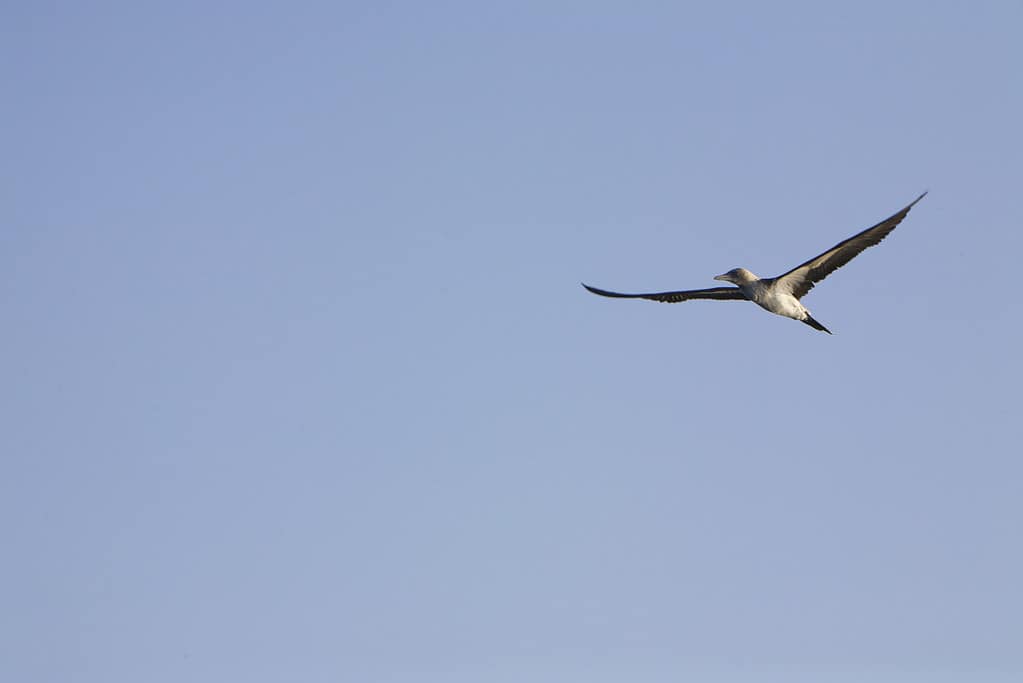
Shearwater breeding colonies are primarily found on Santa Cruz, Española, and Wolf Island.
©Dimasu/iStock via Getty Images
While the shearwater (Puffinus subalaris) ventures as far away as southern Mexico’s Pacific coast, it is an endemic breeder to the Galápagos. A small species, the Galapagos shearwater is most closely related to the Christmas shearwater. These social birds happily feed on squid and fish, alongside other shearwaters and various booby species.
14. Lava Gull
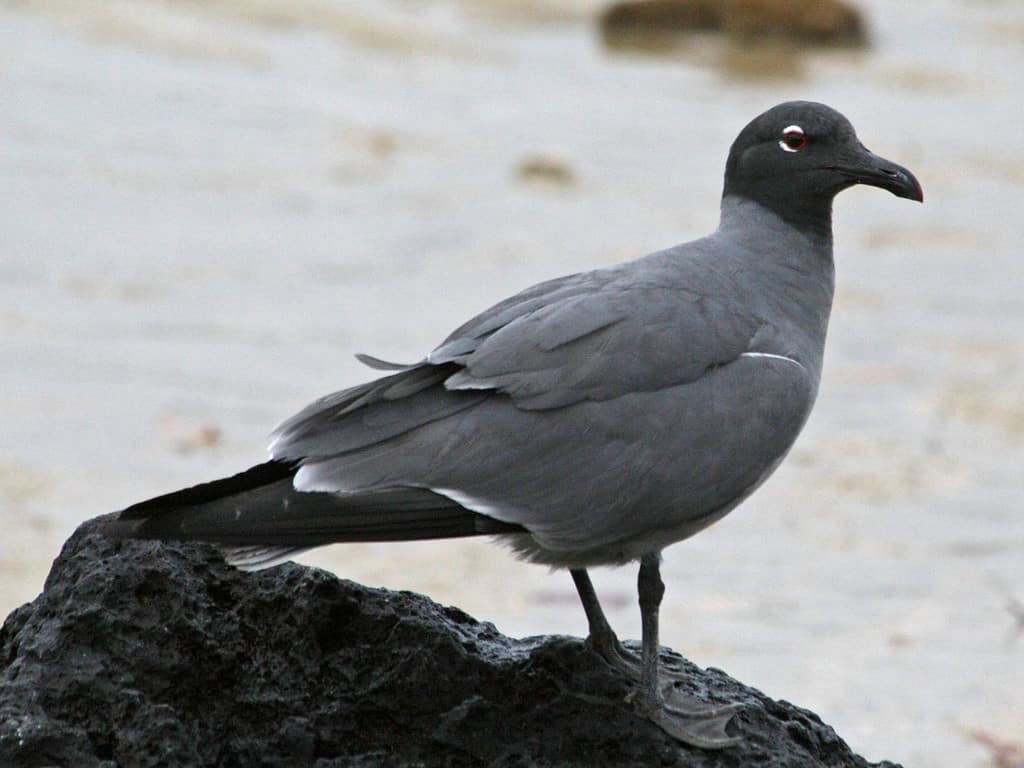
Lava gulls are classified as vulnerable on the IUCN Red List.
©DickDaniels (http://theworldbirds.org/) / CC BY-SA 3.0 - License
With a population of only 300-600 birds, the lava gull (Leucophaeus fuliginosus) is said to be the rarest gull in the world. Though closely related to the widespread laughing gull, the lava gull is only found in the Galápagos, most predominantly on Santa Cruz, Genovesa, Isabela, and San Cristobal Islands. The lava gull is long-lived, with a lifespan of up to 49 years.
13. Galápagos Hawk
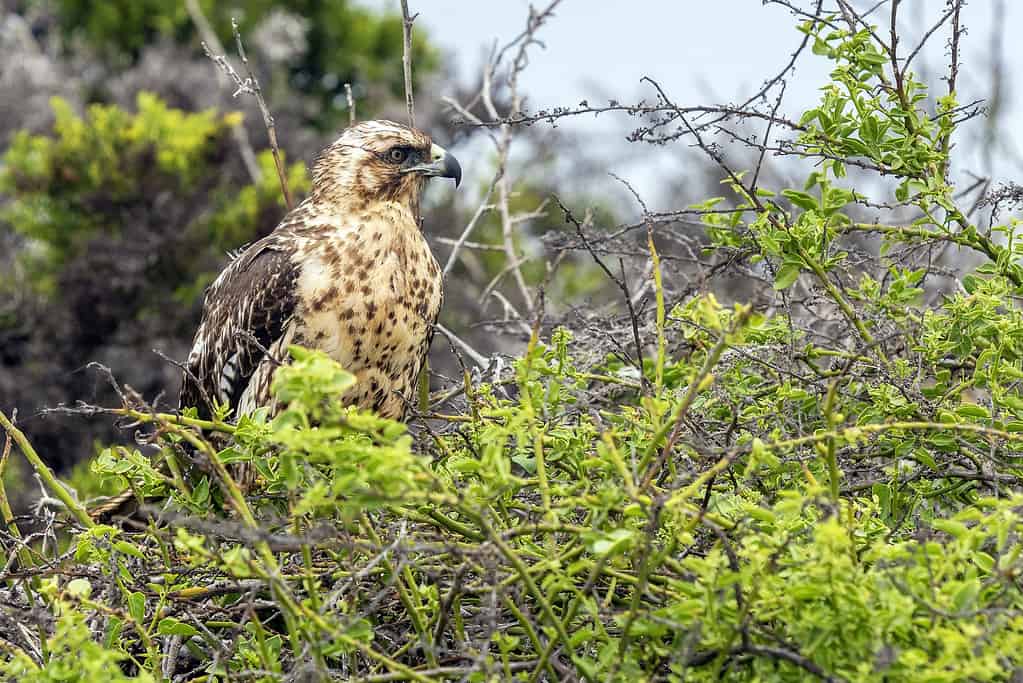
These hawks are “new” arrivals to the Galápagos, first colonizing the islands 300,000 years ago.
©SL_Photography/iStock via Getty Images
The Galápagos hawk (Buteo galapagoensis) is closely related to the red-tailed hawk. Unlike the prolific red-tailed, the Galápagos hawk is one of the rarest raptor species in the world, with an estimated 150 breeding pairs. Despite their large size, these hawks feed primarily on invertebrates like locusts and giant centipedes, though they will also eat lava lizards, young iguanas, small birds, rodents, and carrion. Galápagos hawks are unique in that they practice cooperative polyandry. While the males are monogamous, the females mate with numerous males during the nesting season. The males then help incubate the eggs and raise the chicks.
12. Waved Albatross
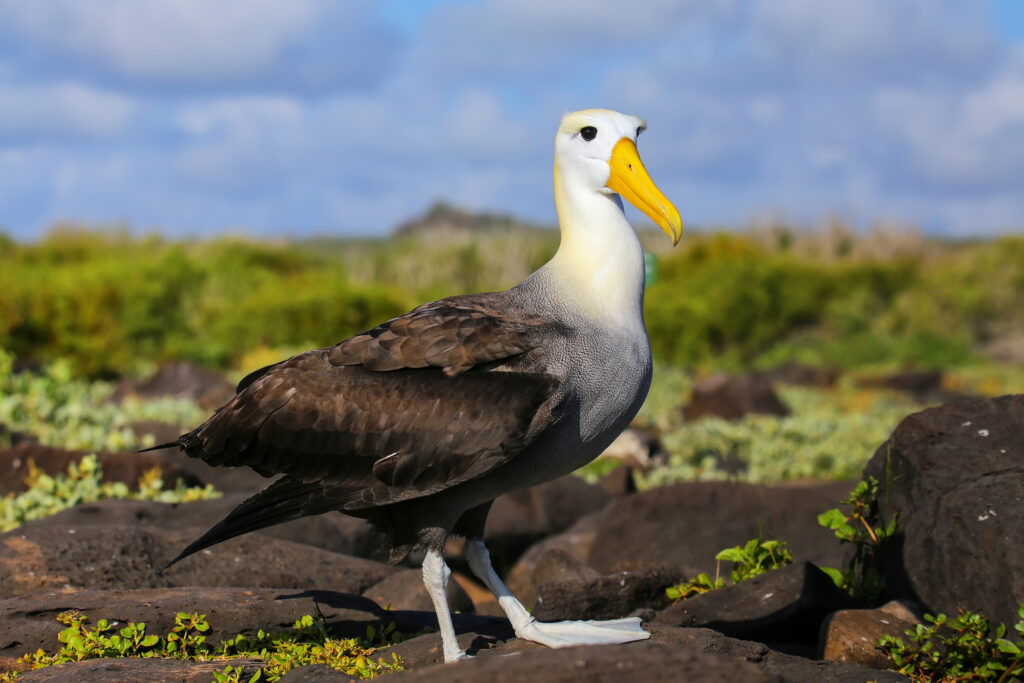
The wave-like pattern on the bird’s wings is what gives this
albatross
its name.
©Don Mammoser/Shutterstock.com
The impressive, waved albatross (Phoebastria irrorate) is the largest bird in the Galápagos. These birds weigh six to over eight pounds and have an impressive wingspan of 7-8 feet that lets them glide across the sky. Remarkably, the albatross can spend years soaring over the ocean without ever touching land, only coming ashore to breed. The waved albatross is classified as critically endangered, with the biggest threats coming from long-line fishing and other human-made hazards.
11. Lava Lizard
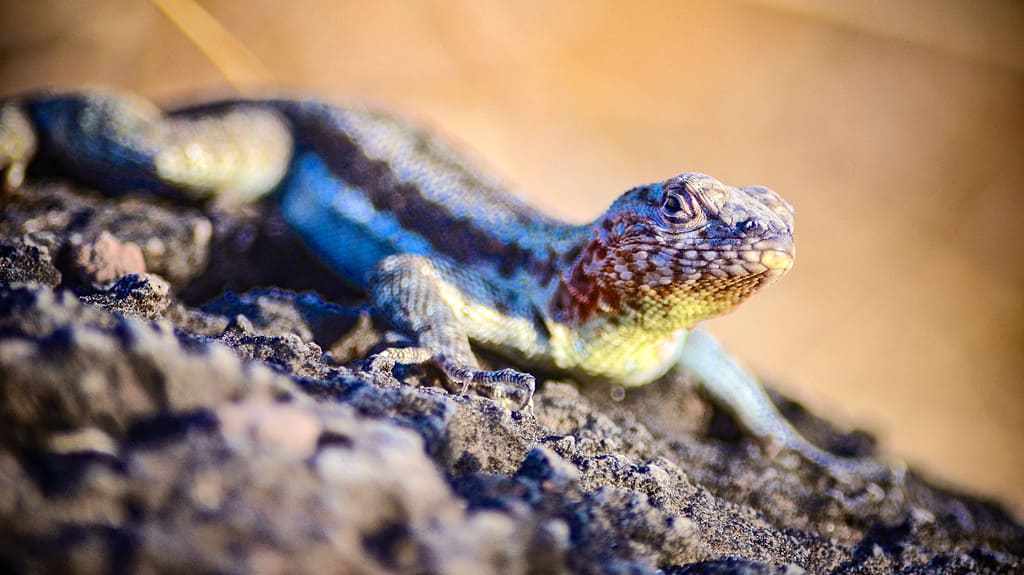
The lifespan of a lava lizard is approximately 10 years.
©marktucan/iStock via Getty Images
Seven species of lava lizard inhabit the Galápagos Islands and they are found on all the islands except Wolf, Darwin, and Genovesa. These small lizards from the genus Microlophus look like miniature iguanas and come in a range of colors. The males tend to be brighter than the females and can often be seen doing “push-up contests” to intimidate other males and protect their territory.
10. Galápagos Penguin
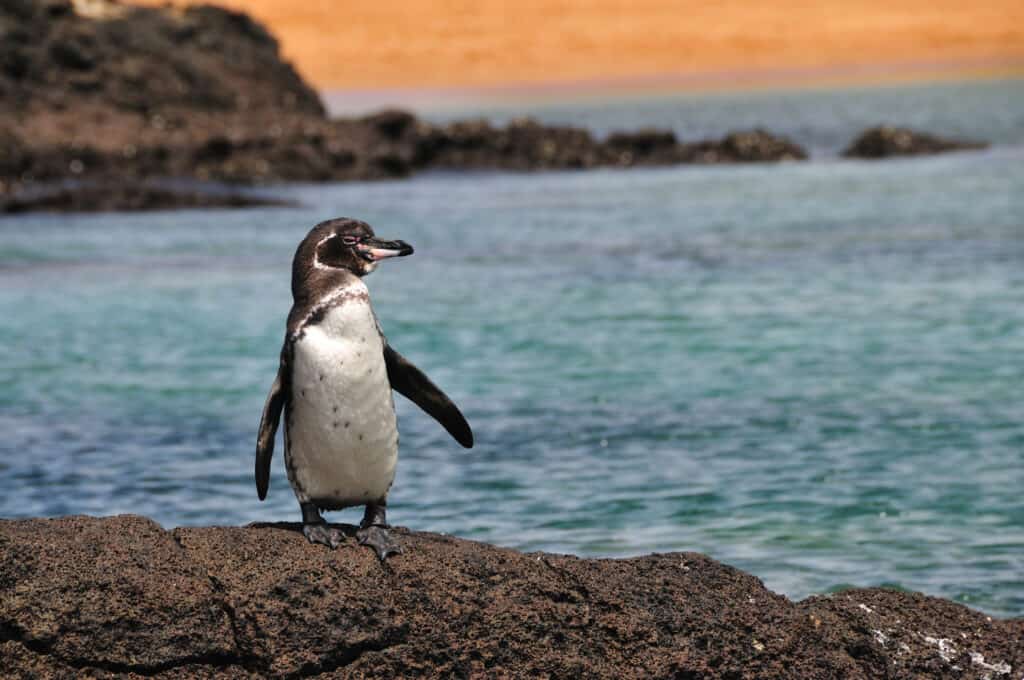
These penguins can reach swimming speeds of over 20 miles per hour.
©iStock.com/jmmf
Looking for a penguin north of the equator? The Galápagos penguin (Spheniscus mendiculus) is the only one. The third-smallest penguin species in the world, they weigh only around four to five pounds. Galápagos penguins are monogamous and can lay up to two eggs at a time; however, if both eggs hatch, the parents will only raise one of them. For chicks that survive to adulthood, the average lifespan is around 20 years.
9. Darwin’s Finches
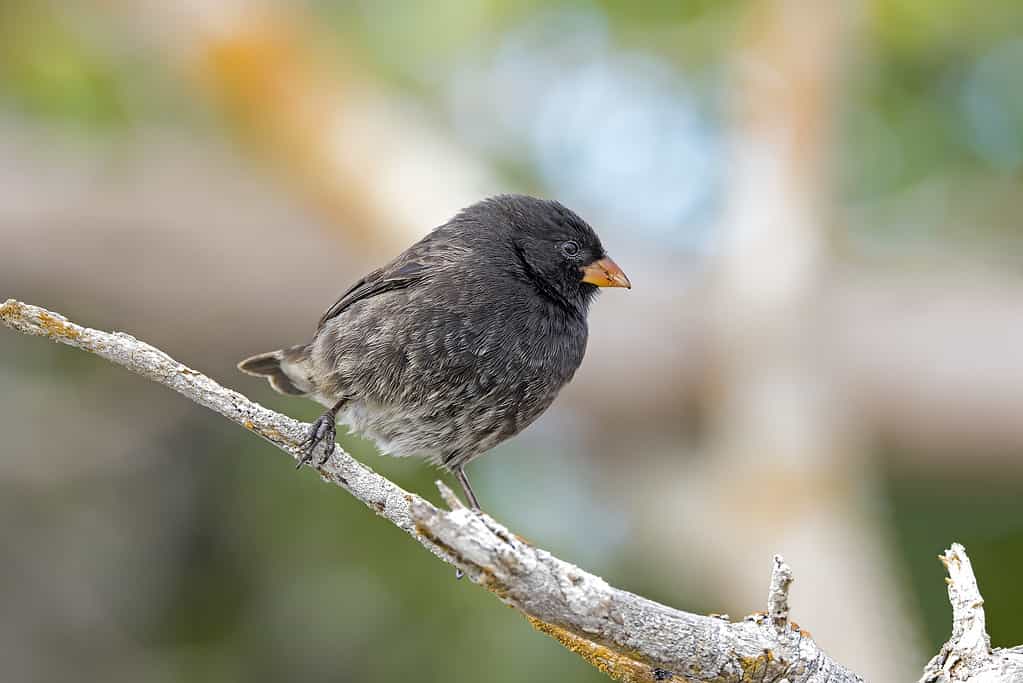
Darwin’s finches are members of the Geospizinae subfamily.
©Franz Schallmeiner/iStock via Getty Images
The 17 species of finches in the Galápagos are often hailed for their role in the development of Darwin’s theory of evolution. After the finches initially arrived on the islands, they evolved into separate species to adapt to the islands’ different environments. Most famously, the unique species evolved to have different beak types adapted to different food types. This allows them to fill specific niches on the islands, with some birds eating cacti, while others eat hard seeds or invertebrates. While the finches are similar in size and color, their habitats, beaks, and diets are a good way to differentiate between the species.
8. Marine Iguana
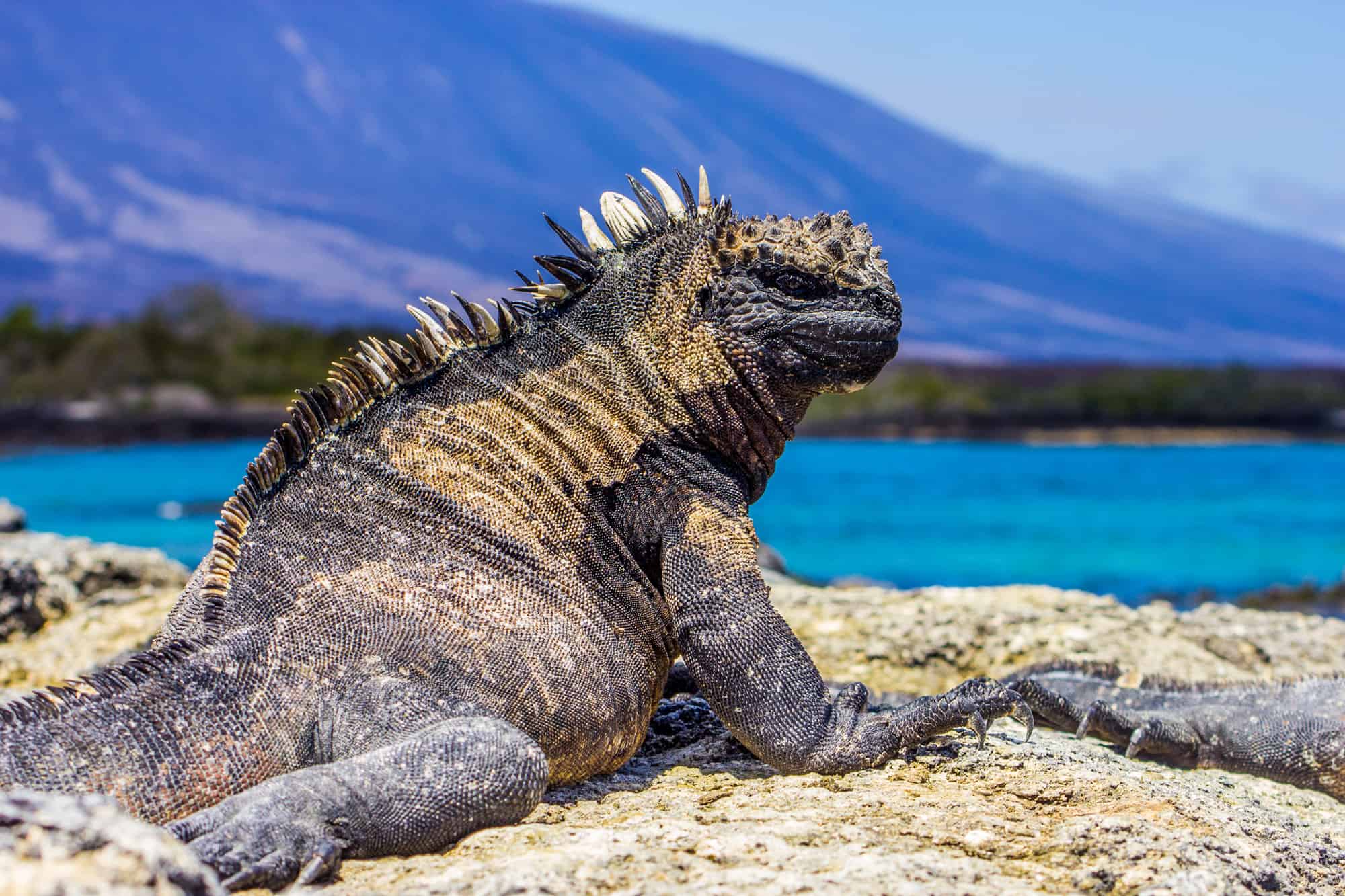
Once a marine iguana enters the water, its heartbeat slows by 50% to conserve energy.
©iStock.com/Fred Chaveton
The rocky coastlines of the islands covered in huge groups of marine iguanas (Amblyrhynchus cristatus) is quite a sight. The world’s only sea-going lizards, they are adept swimmers (though not impressively agile on land). When they aren’t feeding on underwater algae, they bask in the sun, absorbing the heat they need for energy. Across the islands, there are 11 different subspecies, five of which were just identified in 2017. With over 250,000 marine iguanas on the islands, they are seemingly everywhere and vary in size depending on which island they live on.
7. Flightless Cormorant
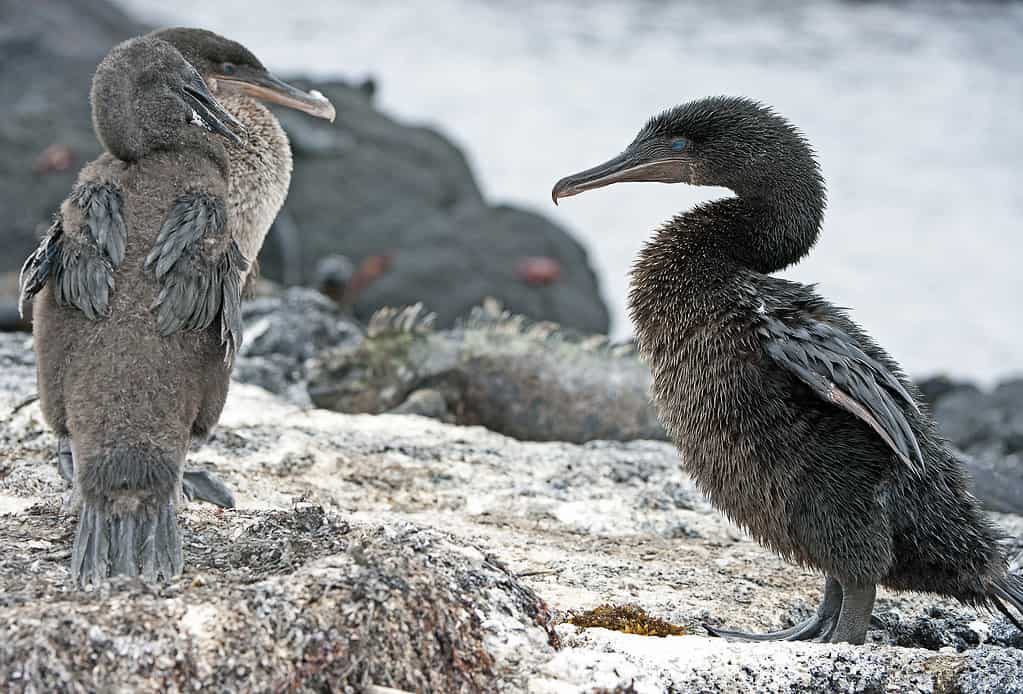
These grounded cormorants kick their powerful feet to propel them through the water.
©pilesasmiles/iStock via Getty Images
The flightless cormorant may be the only one of 29 cormorant species that can’t fly, but they make up for it with excellent swimming skills. A lack of land predators made flying less necessary for these birds, and evolution ended up favoring better swimmers (who were more successful at catching food like octopus and eel) over better flyers. Over time, these birds developed wings that are one-third the size needed to support flying. However, the wings aren’t entirely useless: flightless cormorants use their wings to help them balance while they jump from rock to rock.
6. Galápagos Sea Lion

Pups stay with their mothers for over a year, weaning at 11-12 months.
©Thomas Debay/Shutterstock.com
The most common mammal of the Galápagos animals, sea lions (Zalophus wollebaeki) are found (and smelled… and heard…) along almost every shore of the islands. Males are significantly larger than females, weighing up to four times as much. The males patrol the waters along the beaches where the females live, expressing their dominance loudly through barking calls. More dominant males have larger territories and larger harems. Males without harems form bachelor colonies away from the females. While awkward on land, sea lions are graceful swimmers, hunting for food underwater while keeping an eye out for sharks.
5. Swallow-Tailed Gull
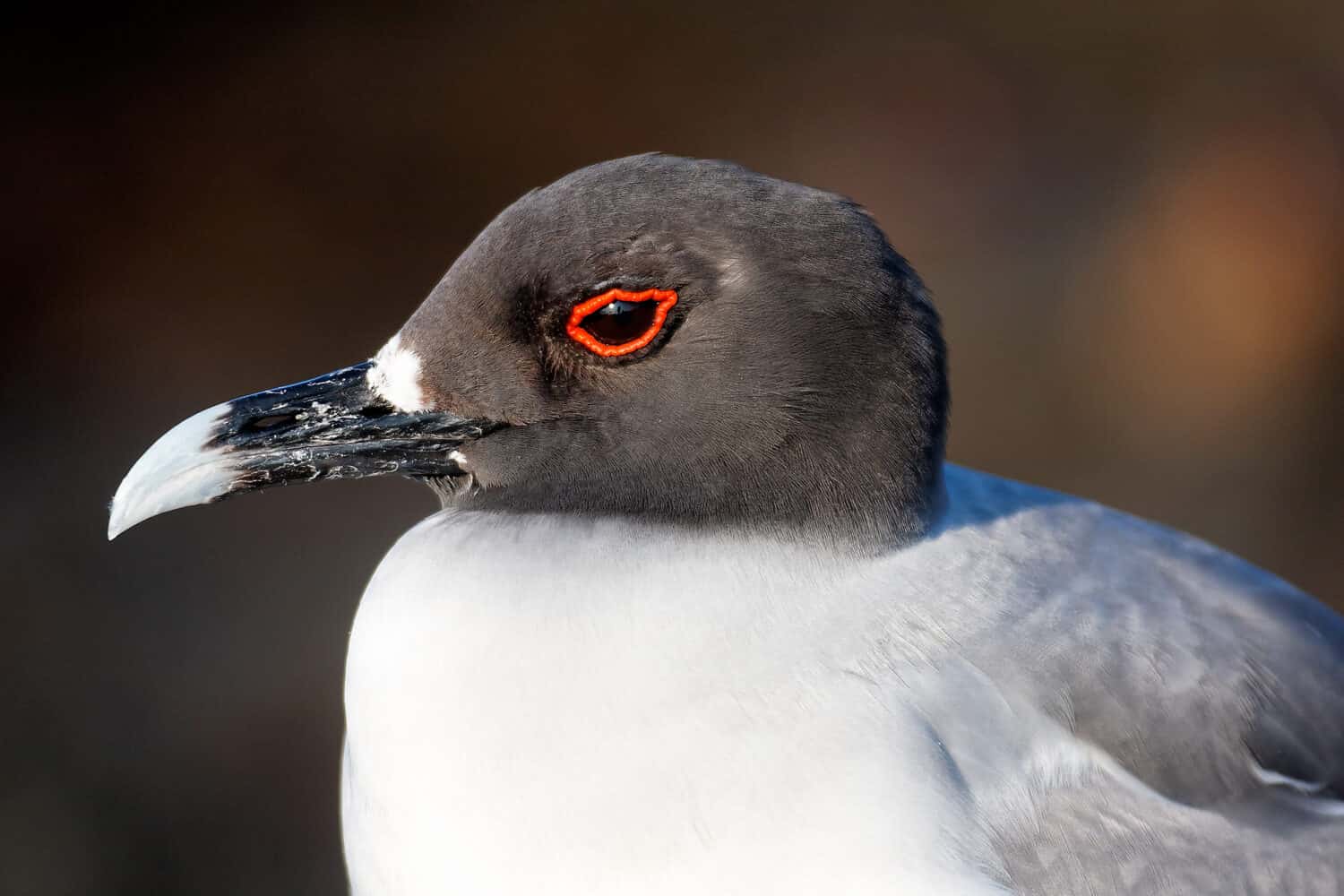
The gull’s eye ring is usually black but turns red during the breeding season.
©goran_safarek/Shutterstock.com
There are over 50 species of gull in the world, but the swallow-tailed gull (Creagrus furcatus) is incredibly unique. The swallow-tailed hunts at night, making it the only nocturnal gull in the world. Additionally, it is the only gull with night vision and has the largest eyes of any gull species. Hunting at night allows the gulls to avoid competition with other seabird species such as frigate birds, which will often steal food from gulls. It also gives them increased access to squid (their favorite food), as squid are most active after dark.
4. Banded Galápagos Snake

Pinzón racers are diurnal but generally avoid the midday heat.
©WMarissen/iStock via Getty Images
Also known as the Pinzón racer, the banded Galápagos snake (Pseudalsophis slevini) is the only snake found on Pinzón Island. The banded snake is one of four endemic species of “racers” found in the Galápagos, all of which are small and brown and similar in size to a garter snake. The banded snake and the Darwin’s racer are the only two snakes in the Galápagos with a banded pattern. Banded Galápagos snakes are mildly venomous, but their venom is not strong enough to be a threat to humans.
3. Galápagos Fur Seal
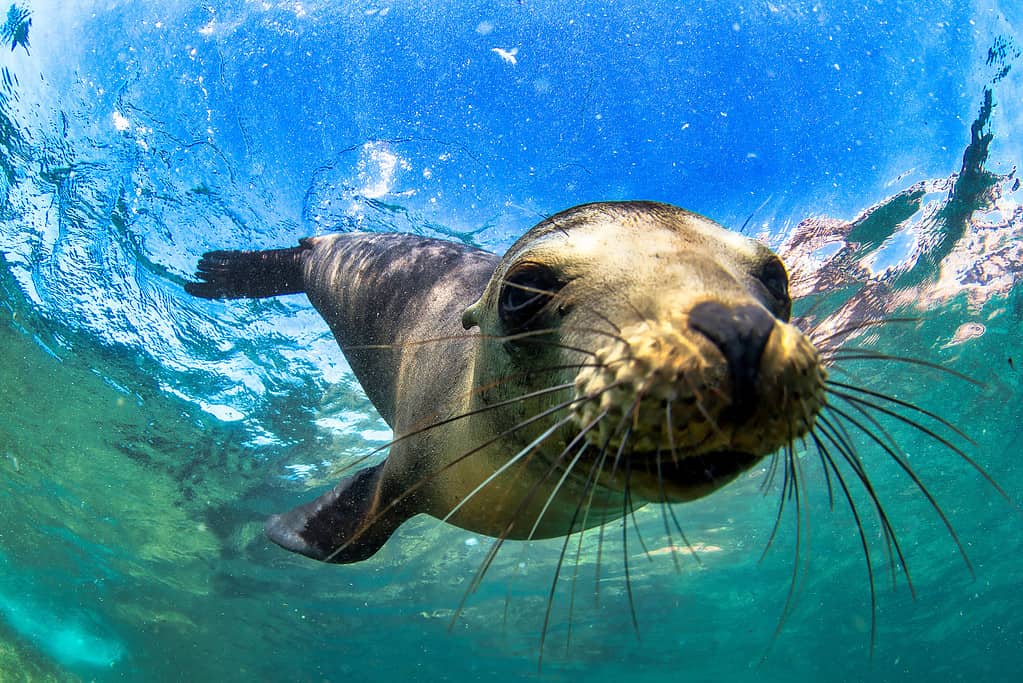
While
fur seal
populations are similar to those of sea lions, they are rarely seen.
©Aleksandr Golubev/iStock via Getty Images
Much smaller than the Galápagos sea lion, the fur seal (Arctocephalus galapagoensis) is commonly found along the western rocky shorelines of the islands during the day, preferring to hunt at night. These nocturnal feeders often make foraging journeys that can last up to 16 hours. They often hunt less during a full moon because the light makes them more visible to predators like sharks. Fur seals feed on cephalopods (such as squid) and fish and can dive up to 160 feet to find prey.
2. Land Iguana
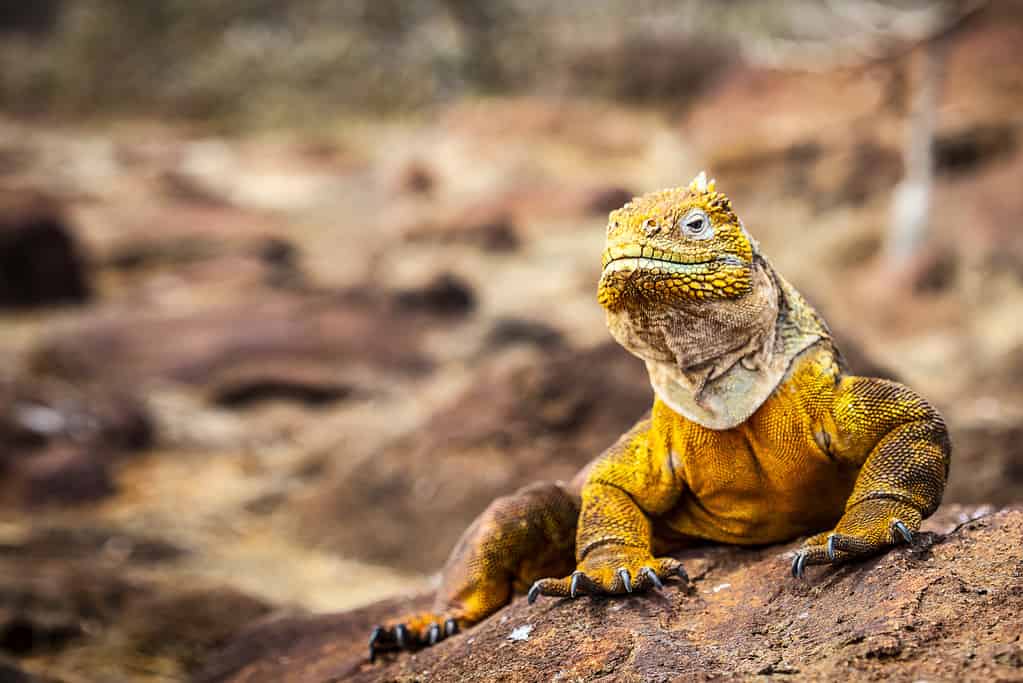
Finches often perch on the back of land iguanas and eat ticks off of their scales.
©Aleksandr Golubev/iStock via Getty Images
There are three species of endemic iguanas in the islands, but the Galápagos land iguana (Conolophus subcristatus) is the largest. As one of the biggest iguanas in the world, these enormous lizards can measure up to 5 feet long and are one of the largest Galápagos animals. These iguanas are also incredibly distinct due to their yellow coloration. Primarily herbivorous, the prickly-pear cactus makes up about 80% of the land iguana’s diet. The iguana also gets most of its fluids from the cactus, enabling it to live in the arid zones of the islands that have few water sources.
1. Galápagos Tortoise
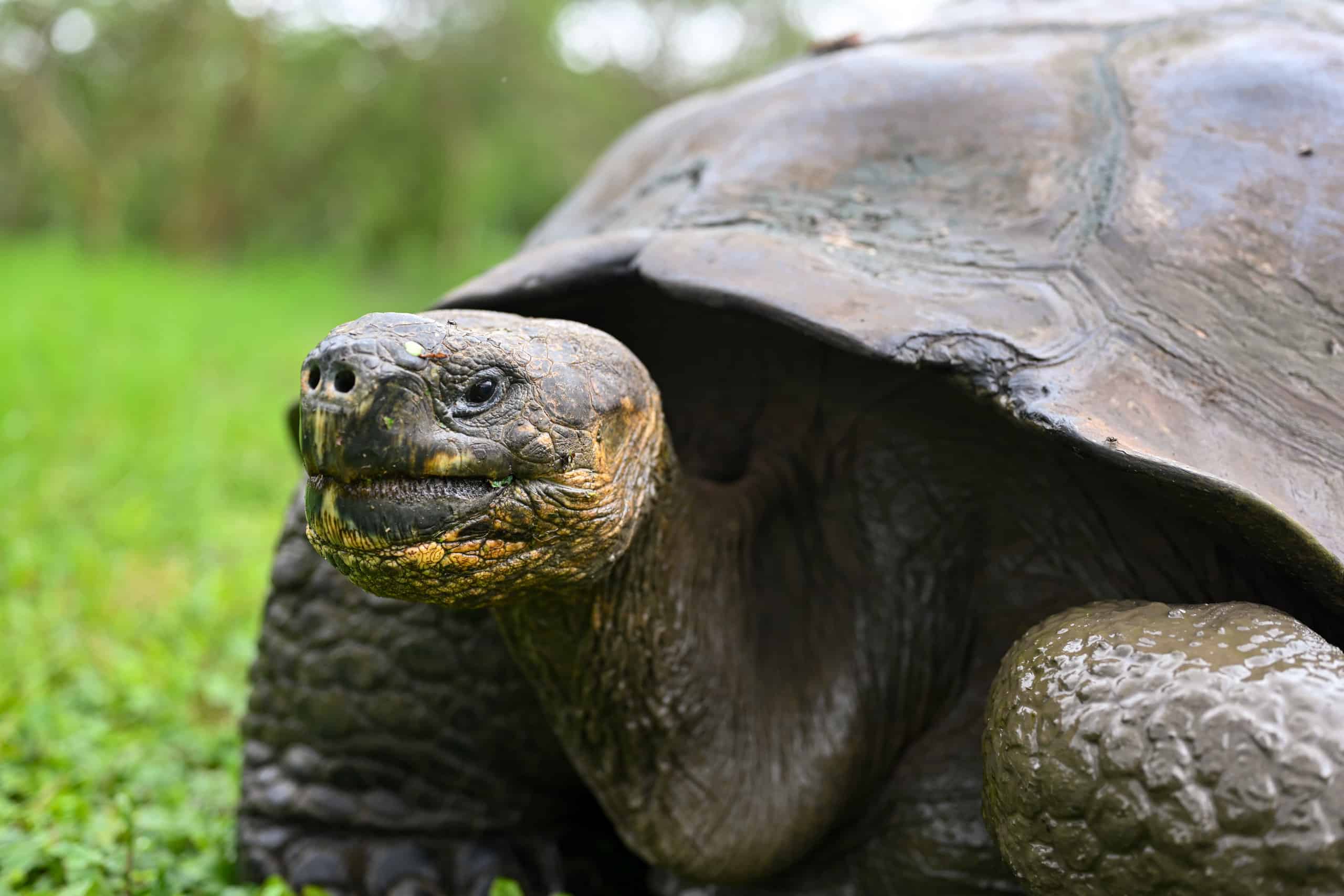
Full-grown tortoises can weigh over 500 pounds.
©Joseph Alexander Cruz/Shutterstock.com
The Galápagos tortoise is one of the most well-known of the endemic Galápagos animals, and it is also the namesake of the islands. The name “Galápagos” is derived from the Spanish word “galapago,” which means “saddle.” Early explorers used this word to describe the shape of the tortoise’s shells.
Currently, 15 identified species of Galápagos tortoises are left on the island, with a population total of around 10,000-15,000. The most famous of these, Lonesome George, was the final remaining tortoise on Pinta Island and died in 2012.
Summary of 15 Animals You’ll Only Find in the Galápagos
| Animal | Scientific Name |
|---|---|
| 1. Galápagos Tortoise | Chelonoidis niger |
| 2. Land Iguana | Conolophus subcristatus |
| 3. Galápagos Fur Seal | Arctocephalus galapagoensis |
| 4. Banded Galápagos Snake | Pseudalsophis slevini |
| 5. Swallow-Tailed Gull | Creagrus furcatus |
| 6. Galápagos Sea Lion | Zalophus wollebaeki |
| 7. Flightless Cormorant | Phalacrocorax harrisi |
| 8. Marine Iguana | Amblyrhynchus cristatus |
| 9. Darwin’s Finches | Geospiza genus |
| 10. Galápagos Penguin | Spheniscus mendiculus |
| 11. Lava Lizard | Microlophus genus |
| 12. Waved Albatross | Phoebastria irrorate |
| 13. Galápagos Hawk | Buteo galapagoensis |
| 14. Lava Gull | Leucophaeus fuliginosus |
| 15.Galápagos Shearwater | Puffinus subalaris |
The photo featured at the top of this post is © iStock.com/Maridav
Thank you for reading! Have some feedback for us? Contact the AZ Animals editorial team.






